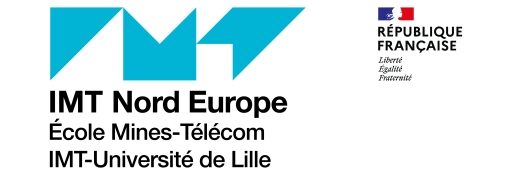Accepted journal papers
Accepted international conference papers
- “Vers une méthode de comparaison sémantique des modèles d’alignements pédago-ludiques réalisés dans le contexte des jeux sérieux”, Madeleine Dufrasne, Anthony Fleury et Alexis Lebis, EIAH 2025
- “La place des mécaniques ludiques dans les Feedbacks : une revue systématique de la littérature”
Adrien Chassaing-Monjou, Alexis Lebis, Mathieu Vermeulen, Anthony Fleury et Nour El Mawas, EIAH 2025 - “De l’itératif à la navigation accompagnée : une évolution des méthodes de conduite de la recherche”, Nadine Mandran, Alexis Lebis et Mathieu Vermeulen, EIAH 2025
- “Epistémologie instrumentée en EIAH : retour sur l’outil SEED”, Nadine Mandran et Alexis Lebis, EIAH 2025
- “Une hybridation repensée : Définition, modèle, méthode”, Benoît Martinet, Alexis Lebis, Mathieu Vermeulen, Nadine Mandran et Nour El-Mawas, EIAH 2025
Accepted national conference papers
- “Performances Optimales Pour Le Modèle Harmonique Multidimensionnelle, Multicanal Avec Couplage”, Clémence Prévost, Maxence GIRAUD, Vincent Itier, Remy Boyer, GRETSI 2025
- “Maximiser la marge pour une détection robuste des photomontages”, Julien SIMON de KERGUNIC, Rony Abecidan, Patrick Bas, Vincent Itier, GRETSI 2025
- “Génération d’Images et Insertion d’un Message Caché dans l’Espace Latent Glow”, Aurélien Noirault, Jan Butora, Vincent Itier, Patrick Bas, GRETSI 2025
- “DeepFake Detection based on Noise Residuals”, Minh Thong Doi, Jan Butora, Vincent Itier, Jérémie Boulanger, Patrick Bas, GRETSI 2025
- “Région de débits atteignable en NOMA avec amplificateur non linéaire”, Gaston Philippe, Arthur Louchart, Anne Savard, GRETSI 2025
- “Approximation efficace des LLR pour les canaux à bruit additifs symétriques alpha-stables”, Anne Savard, GRETSI 2025
Accepted research projects
Upcoming PhD defenses
July 2, 2025: Asbathou BIYALOU-SAMA
Title: Editing models differently in application design with MDE: from application GUIs to model editing
Abstract:
Model-Driven Engineering (MDE) is a software engineering approach that emphasizes the extensive use of models throughout the system development lifecycle. It aims to structure and automate design, analysis, code generation, and system evolution. By abstracting system complexity and separating concerns, MDE relies on models and model transformations to enhance productivity, reduce repetitive manual tasks, and ensure traceability and consistency across development phases.
In this work, we consider a scenario where a transformation chain automatically generates all artifacts required for application execution, including code, database structure, user interface, and business logic. This transformation chain is based on models that must be edited using model editors, which are essential for MDE-based system evolu- tion. While these editors facilitate model manipulation, a cognitive gap persists between model editing and application testing. This constant shift between design and execution introduces cognitive disruptions that may hinder the development process.
To address this issue, we propose leveraging the graphical user interface of the application under development as a model-editing tool. As designers frequently interact with this interface—often more intuitive than traditional model editors—our approach allows them to modify models in a seamless and natural manner, eliminating the need to switch between multiple tools.
We implemented a prototype of this model-editing approach within an existing web application generation framework to validate its feasibility. This prototype enabled us to assess the modeling effort required and demonstrated a reduction in the number of tasks needed for model editing. Subsequently, we designed a reproducible software architecture adaptable to other compilation chains. A key challenge was ensuring that this architecture does not interfere with the compilation process, allowing the removal of additional components once the application is finalized.
To validate our architectural proposal, we conducted technical implementations on two distinct application generation frameworks: the same web application generation framework used for the initial prototype and Sirius Desktop, a diagram description framework. Additionally, we explore an ongoing effort to simplify and automate the deployment of our architecture by applying MDE principles. This involves using a meta- model to structure and partially generate specific software architecture components.
Our approach introduces a novel paradigm for designing editors in low-code/no-code methodologies, enabling domain-specific low-code editor creation. Finally, we discuss how this research paves the way for the development of application digital twins, which represents a key perspective of this work.
Keywords: models, mde, model editing, graphical modeling tools, gui, software architecture, transformations, compilation chains, model instrumentation, tooling, ui4me
One thought on “News”
Leave a Reply
You must be logged in to post a comment.

Ceci est un exemple d’un commentaire dans WordPress. Vous pouvez la modifier pour mettre ici des informations vous concernant ou concernant votre site afin que vos lecteurs en sachent un peu plus sur vous. Vous pouvez créer autant de commentaires que vous voulez, et gérer l’intégralité de votre contenu dans WordPress.